Abstract
Aim:
The present study investigates the effect of combined treatment with Ginkgo biloba and/or Rhodiola rosea on psychomotor vigilance task (PVT) and short-term working memory accuracy.
Subjects and Methods:
A total number of 112 volunteers were enrolled to study the effect of G. biloba and R. rosea on PVT and short-term working memory accuracy as compared to placebo effects, the central cognitive effect was assessed by critical flicker-fusion frequency, PVT, and computerized N-back test.
Results:
Placebo produced no significant effects on all neurocognitive tests measure P > 0.05 in normal healthy volunteers, G. biloba or R. rosea improve PVT and low to moderate working memory accuracy, The combined effect of R. rosea and G. biloba leading to more significant effect on PVT, all levels of short-term working memory accuracy and critical fusion versus flicker P < 0.01, more than of G. biloba or R. rosea when they used alone.
Conclusion:
The combined effect of R. rosea and G. biloba leading to a more significant effect on cognitive function than either G. biloba or R. rosea when they used alone.
KEY WORDS: Ginkgo biloba, Rhodiola rosea, neurocognitive tests
INTRODUCTION
Most of the registered psychotropic drugs that were licensed are synthetic and natural agents prior to 2007, although the contemporary trend includes an array of natural agents that produced a significant neuroprotection against different neurological diseases and age-induced cognitive dysfunctions [1]. Since, some of the synthetic agents are toxic with low efficacy profile; therefore, psycho neuroactive herbal extracts and their phytochemical are tried for their potential effects on memory, cognitive, and vigilance functions [2]; therefore, Ginkgo biloba, Rhodiola rosea, and other herbal medicines are marketed widely with expectation of preventing and delaying cognitive impairment with augmenting of normal brain functions [3].
G. biloba is confidential in its own partition as class Ginkgoopsida, order Ginkgoales, family Ginkgoaceae and genus Ginkgo, it has widely used in traditional medicine, G. biloba extracts contain various constituents which include, ginkgolides, bilobalides, flavonoid glycosides, phenolic acid, and quercetin [4]. In addition, G. biloba biflavones and polyphenols have potential neuroprotective effect in Alzheimer dementia via inhibition of amyloid fibrils accumulation [5]. Moreover, G. biloba delayed age-induced cognitive decline and may have more delicate and subtle therapeutic effects on the speed of cognitive alterations [6].
R. rosea is a traditional medicinal herb have about 140 active constituents such as flavonoid, alkaloids, rosin, rosarin, and phenols, its belong to Crassulaceae family, grow mainly at high altitude in Asia and Europe, the medicinal and pharmacological properties of R. rosea are species dependent and most of the human and animal studies conducted on R. Rosea. Since, it passed sophisticated and extensive pharmacological studies and had been certified safe for both humans and animals [7].
R. rosea contain an active constituent called salidroside which has various and multiple pharmacological effects include, anti-oxidant, anti-ischemic, anti-hypoxic, and neuroprotection [8].
Moreover, long-term therapy with R. rosea leads to central nervous system stimulation; improve psychomotor performance and improvement of cognitive function [9].
Therefore, the purpose of the present study was assessing the effect of G. biloba and/or R. rosea on psychomotor vigilance task (PVT) and short-term working memory accuracy in normal healthy volunteers.
SUBJECTS AND METHODS
This study was done in Department of Clinical Pharmacology, College of Medicine, Al-Mustansiriya University, in Baghdad-Iraq from January to April 2015. Enrolled volunteers were meeting and consulates on their healthy status. Exclusion criteria for the volunteers were psychiatric, metabolic, neurological, and other medical disorders. All volunteers were recommending not drinking caffeine, stimulant drugs, and alcohol containing beverage for at least 5 days before starting the study. The volunteers enrolled in this study signed well-read consent to their involvement in this study, according to the Declaration of Helsinki. The research protocol was endorsed and approved by a scientific board in Department of Clinical Pharmacology and College Medical Committee.
In this double-blind, randomized, the placebo-controlled study, a total number of 112 volunteers (60 males and 52 females) with mean age of 22 years were engaged from College of Medicine, Al-Mustansiriya University. They are diving into the following groups:
Group A: 30 volunteers (15 males, + 15 females) treated with starch 500 mg/day.
Group B: 27 volunteers (15 males + 12 females) treated with G. biloba capsule 60 mg/day (standardized to contain 24% Ginkgo flavone glycosides) SANTASYA Ltd.
Group C: 25 volunteers (15 males + 10 females) treated with R. rosea capsule 500 mg/day (standardized to contain 5% receiving) Rhodiola India UPC Code 790011140702.
Group D: 30 volunteers (15 males + 15 females) treated with both G. biloba capsule 60 mg/day and R. rosea capsule 500 mg/day. The duration of therapy was 10 days, subsequently, each volunteer in the groups performed neurocognitive tests that measured by a special device called a Leeds psychomotor battery tester (Zac-Gmbh.D-8346-Simbach/Inn), which measure the followings:
Critical Flicker-Fusion Frequency (CFFF)
A training period of the test was allowable and supported, this test made in a dim room. The device calculates records and lists the results. The Leeds psychomotor battery tester encloses four red emitting diodes situated in the corner of 1 cm2 in surplus of a black panel, each volunteer be supposed to sit in front of device to guarantee 75-100 cm of distance between the device and eyes, which allows binocular vision for flicker-fusion awareness and discrimination, the flicker happen in frequency that ranged from 1 Hz to 60 Hz. On an elevating trail, the volunteer watches the four red lights flickering and should press the key as soon as possible when as they appear fused, this called ascending critical or fusion frequency (ACFF), whereas awareness of fusion light until to be flickering named as descending critical or flicker frequency (DCFF). The standard average of five fusions and flickers representing the cortical arousal activity, deterioration in either ACFF or DCFF indicating arousal disorders; furthermore, when ACFF value more than 30 Hz (near 60 Hz) and DCFF values <30 Hz (near 1 Hz) indicating a good arousal activity, and from the exceeding values a CFFF can be estimated where CFFF=DCFF+ACFF/2 [10].
PVT
The Leeds psychomotor performance tester advice was useful for estimations of total reaction time in ms (TRT), which observed as a marker for the assessment of sensorimotor reaction to the critical stimuli. The volunteer asked to place the index finger on the central button and teaches to press urgent red light appearance sites as soon as possible, the mean of five successive readings is recorded and listed on digital screen as TRT in ms and recognition reaction time in ms (RRT). TRT represents the time for the onsets of a stimulus to the end of the reaction in ms, while RRT represents the time for the onsets of a stimulus to the beginning of motor action consequently, TRT minus RRT equal to movement reaction time which represent the time from the end of stimulus recognition to the end of motor actions [11].
Short Term Working Memory Accuracy Test (Computerized N-Back Test)
This test was performed on the laptop screen; the eight squares at different sites were reachable consecutively on laptop monitor at a rate of three seconds, an answer was requested each time, and then single site reverses in sequence. In one-back test, the volunteer detect and seek squares site in relation to the preceding square, in two-back test, the volunteer detect and seek square site in relation into two reverse trails of the preceding square, while in a three-back the volunteer detects and seek square site in relation into three reverse trails of the preceding square. The laptop monitor consecutively measuring and counting short-term working memory accuracy (number of corrected responses) through pressing the letter A on laptop keyboards, one back (I-BACK) representing low-level, two back (II-BACK) representing a moderate level, whereas, three back (III-BACK) represent a high level of accuracy% [12].
All neurocognitive tests were measured before taking drugs as the first measure while the second measure performed on the 10th day of the experiment after 4 h of the last dose of the drug, since repeated measurements may lead to adaptation.
Data Analysis
Data obtained were presented as mean ± standard error; different groups were compared using paired Student’s t-test. The significance of differences was considered when P < 0.05 regarded as the lower border of significance.
RESULTS
Consort flow diagram demonstrated the number of participants in this randomized and placebo-controlled study a total number of 120 participants were enrolled, only eight participants were withdrawn from this study due to non-compliances, not met inclusions criteria and other reasons, while 112 participants were continued the neurocognitive studies [Figure 1].
Figure 1.
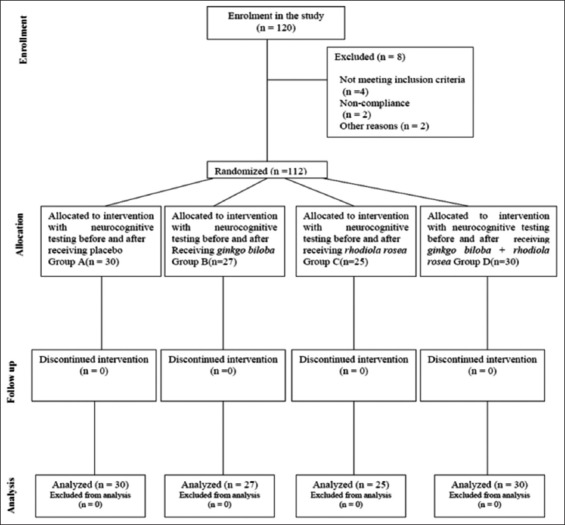
Flow diagram of study design
Placebo produced no significant effects on all neurocognitive tests measure P > 0.05 in normal healthy volunteers after 10 days of treatment [Table 1].
Table 1.
The placebo effects on the neurocognitive variables on normal healthy volunteers

G. biloba 60 mg/day for 10 days therapy produced significant effects on PVT P < 0.01, insignificant effects on CFFF parameters P > 0.05 with mild significant effect on ACFF P < 0.05 and significant effects on short term working memory accuracy only for I-BACK WMA and II-BACK WMA P < 0.01 but not for III-BACK WMA P > 0.05 [Table 2].
Table 2.
G. biloba effects on the neurocognitive variables on normal healthy volunteers
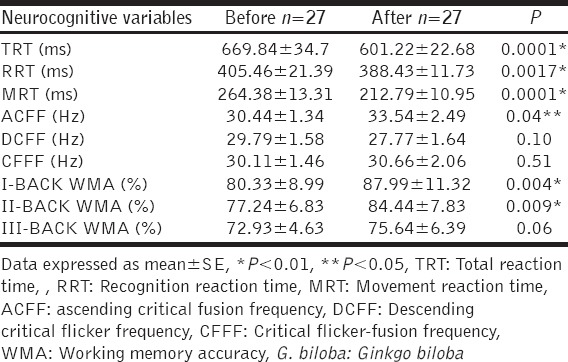
Therefore, G. biloba improves PVT and low to moderate working memory accuracy.
R. rosea 500 mg/day for 10 days therapy produced significant effects on PVT P < 0.01, insignificant effects on CFFF parameters P > 0.05 with mild significant effect on ACFF P < 0.05 and significant effects on short term working memory accuracy only for I-BACK WMA and II-BACK WMA P < 0.01 but not for III-BACK WMA P > 0.05 [Table 3].
Table 3.
Rhodiolarosea effects on the neurocognitive variables on normal healthy volunteers
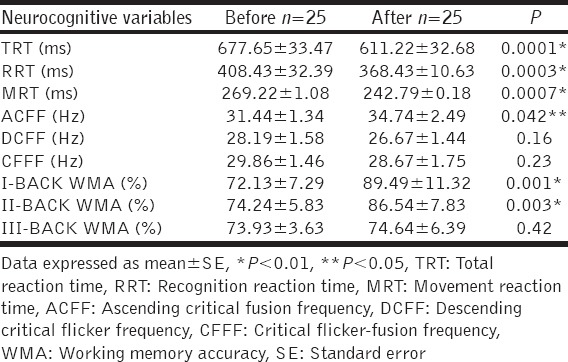
Therefore, R. rosea improves PVT, ACFF, and low to moderate working memory accuracy.
Therefore, R. rosea and G. biloba have similar central effects, but combined G. biloba 60 mg/day plus R. rosea 500 mg/day for 10 days therapy in normal healthy volunteers’ demonstrated central additive effects more than either R. rosea or G. biloba when they used alone.
The combined effect of R. rosea and G. biloba leading to more significant effect on PVT P < 0.01, improve both ACFF and DCFF significantly P < 0.05 without amelioration of CFFF P > 0.05 also, they produced significant effects on short-term working memory accuracy at all levels, i.e. they significantly improve I-BACK WMA, II-BACK WMA, and III-BACK WMA P < 0.01 [Table 4].
Table 4.
Combined effect of Rhodiolarosea and G. biloba on the neurocognitive variables on normal healthy volunteers

60 males and 52 females enrolled in this study revealed insignificant differences in the response for the neurocognitive tests, which indicating a gender in significant differences to the responses of neurocognitive stimuli after the combined effects of R. rosea and G. biloba P > 0.05 [Figure 2].
Figure 2.
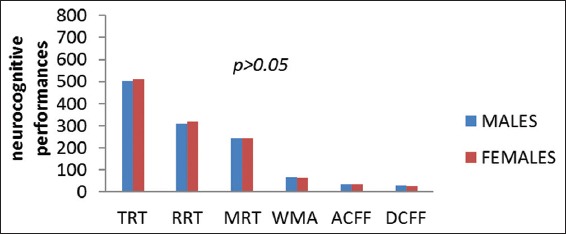
Gender differences in response to the neurocognitive stimuli
Differential effects of G. biloba and/or R. rosea on working memory accuracy compared with placebo effect [Figure 3].
Figure 3.
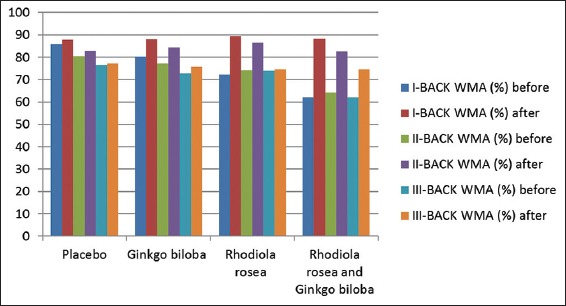
Improvements in working memory accuracy regarding Ginkgo biloba and/or Rhodiola rosea effects
DISCUSSION
A neurocognitive test which includes PVT, critical fusion versus flicker frequency, and short-term working memory accuracy are a reliable and simple test for estimation and evaluation of central arousal state [13] that used in the present study to investigate different herbal agents, which mainly acts as cognitive enhancers. These tests are affected by many factors which include, gender, age, race, and healthy factors thus in the present study a younger age group of both males and females Iraqi medical students were included to exclude gender, race, and age difference in the neurocognitive response from the present study. Indeed, many studies shown significant deterioration of cognitive performances associated with elderly and diseased stating also; there are a significant controversy about race factor effects on cognitive functions of psychomotor performance testing [14].
The present study demonstrated that placebo may produce changes before and after 10 days duration of therapy on the neurocognitive variables mainly on total reaction time but, not reached to the level of significant P > 0.05. Draganich and Erdal, 2014 study revealed that placebo therapy may affect the cognitive function of both negative and positive directions, suggesting a means of controlling vigilance, memory, and cognitive functions [15].
The present study also demonstrated that Ginkgo biloba was significantly improved the neurocognitive variables of the cognitive function, chiefly on the PVT, upgrade low and moderate levels of short-term working memory accuracy and mild improved in ACFF without significant effects on CFFF and DCFF. Kennedy and Wighman, 2011 research revealed G. biloba extract significantly accelerating psychomotor performances, memory, and vigilance function throughout different mechanisms, G. biloba contains a numeral biologically active constituents (ginkgolides, bilobalide, and terepenes) which lead to potential central effects on induction of brain constitutive nitric oxide synthase, neuromodulation effect through inhibition of neural platelet activating factor, inhibition of monoamine oxidase enzyme that lead to significant neurotransmitters augmentation and neuroprotection through inhibition of oxidative stress and down-regulation of free radical generations [16], which may explain the positive effects of G. biloba on memory and psychomotor performances in the current study.
Moreover, a randomized human control trials have revealed cognitive improvement and enhancement in both older and younger age groups subsequent a single doses of G. biloba for 7 days [17], a study corresponding with the result of present study to the enhancement outcome of G. biloba on neurocognitive variables within 10 days duration of treatment, whereas animal models cognitive study done by Yoshitake et al., 2010 exhibited that chronic but not acute therapy with G. biloba extracts improve cognitive function through increased dopaminergic neurotransmission in the prefrontal cortex [18].
Furthermore, Gavrilova et al., 2014 study demonstrate that acute and chronic G. biloba treatment resulted in improvements in vigilance, attention, cognitive performance, decision-making function, and low to moderate but not high working memory accuracy [19], as demonstrated in the present study.
In additional, Al-Kuraishy et al., 2014 psychometric study reported that dopaminergic advancing agents like sertraline and bupropion will accelerate working memory, and psychomotor performances in the similar manner of G. biloba effects due to augmentation of synaptic dopamine, also G. biloba improve muscarnic receptor that involved in modulation of memory and cognitive functions [20].
Indeed, central G. biloba effects may be through blocking over-activated NMDA receptors leading to neuroprotection from excitotoxicity during direct or indirect CNS stimulations [21].
Other possible explanations for the enhancement effects of G. biloba may be related to the up-regulation of genes transcription in cerebral cortex and hippocampus which were linked with learning, memory and cognition functions. Dietary G. biloba extract up-regulated 16 folds for genes responsible for a synthesis of transthyritin (protein transport retinol binding protein and thyroxine in CSF), transthyritin improve the neural integrity and cognitive performances [22], and unfortunately gene encoding assay is unavailable in Iraq.
Furthermore, the present study confirmed R. rosea was significantly improving the neurocognitive variables of cognitive function primarily on PVT; advance low and moderate levels of short-term working memory accuracy and mild progress in ACFF without significant effects on CFFF and DCFF. The present results are in corresponding with a numerous studies that showed R. rosea administration leads to CNS stimulation, enhance working memory, and improve cognitive function in addition to the antioxidant effect on free radicals scavenging effect and neuroprotection [23,24].
Moreover, the phytochemical analysis revealed that R. rosea contain strong constituents called salidroside which has time and dose dependent anti-oxidant and neuroprotective effects [25]. In addition, salidroside augments hippocampus serotonin levels and reduced inflammatory changes [26], which may explain the positive effects of R. rosea on working memory in the current study.
Animal experimental study of salidroside on cognitive function pointed out that R. rosea modulate cerebral neurotransmission and hypothalamic-pituitary axis since most of antidepressant and anti-inflammatory agents improve cognitive function [27].
Regarding the combined effect of both R. rosea and G. biloba on cognitive functions, they significantly improve the neurocognitive variables of cognitive function principally on PVT; advance low, moderate and high levels of short-term working memory accuracy and mild progress in ACFF and DCFF without significant effects on CFFF.
Our findings match Zang et al., 2009 research that showed the combined effect of G. biloba and R. rosea accelerate and improve cognitive performance through increasing oxygen consumption and protecting against central and physical fatigues [28].
Therefore, this combination leads to central additive effect on cognitive function, PVT, and short-term working memory, since combines G. biloba, one of most broadly used herbs for a brain, with the R. rosea lead to maintain mental performance, mood balance, provides antioxidant protection for the brain, improve glucose metabolism, elevation of serotonin levels, and cognitive function [29,30].
Finally, there are insignificant gender differences in cognitive enhancement effect of this combination in response to the neurocognitive stimuli and reactions; this finding was supported by Kim et al., 2015 study which showed a non-significant differences in the cognitive reaction in younger but not in older with or without Alzheimer dementia [31].
CONCLUSION
The combined effect of R. rosea and G. biloba leading to more significant effect on cognitive function than either G. biloba or R. rosea when they used alone.
Suggestions for Future Research
Study different doses of R. rosea and G. biloba on psychomotor vigilance task and short-term working memory accuracy
Estimation of orexin plasma levels to evaluate central effect of R. rosea and G. biloba on psychomotor vigilance task and short-term working memory accuracy
Study the central improvement effect of R. rosea and G. biloba on psychomotor vigilance task and short-term working memory accuracy on elderly patients with dementia
Gender differences in central effect of R. rosea and/or G. biloba.
Limitations of the Study
I study the central effect of R. rosea and/or G. biloba in normal healthy volunteers
Limitations of the availability of modern highly sensitive devices
Similarly, the educational level of the undergraduate medical student groups was known to affect vigilance and short term working memory but this indicator was not included in the present study or compared with other educational levels.
Footnotes
Source of Support: Nil
Conflict of Interest: None declared.
REFERENCES
- 1.Ojizeh I, Eghafona O. Nutritional and physicochemical profiles of some indigenous extracts used in alternative medicine. J Intercult Ethnopharmacol. 2014;3:29–36. [Google Scholar]
- 2.Jain D, Gangshettiwar A. Combination of lycopene, quercetin and poloxamer 188 alleviates anxiety and depression in 3-nitropropionic acid-induced Huntington’s disease in rats. J Intercult Ethnopharmacol. 2014;3:186–91. doi: 10.5455/jice.20140903012921. [DOI] [PMC free article] [PubMed] [Google Scholar]
- 3.Tulunay M, Aypak C, Yikilkan H, Gorpelioglu S. Herbal medicine use among patients with chronic diseases. J Intercult Ethnopharmacol. 2015;4:217–20. doi: 10.5455/jice.20150623090040. [DOI] [PMC free article] [PubMed] [Google Scholar]
- 4.Avula B, Sagi S, Gafner S, Upton R, Wang H, Wang M, et al. Identification of Ginkgo biloba supplements adult ration using high thin layer chromatography and ultra high performance liquid chromatography-dioide – array detector-quadruple pole time of flight-mass spectrometry. Anal Bioananal Chem. 2015;407:7733–46. doi: 10.1007/s00216-015-8938-1. [DOI] [PubMed] [Google Scholar]
- 5.Nabavi SM, Habtemariam S, Daglia M, Braidy N, Loizzo MR, Tundis R, et al. Neuroprotective effects of ginkgolide B against ischemic stroke: A review of current literature. Curr Top Med Chem. 2015;15:2222–32. doi: 10.2174/1568026615666150610142647. [DOI] [PubMed] [Google Scholar]
- 6.Zhang M, Cai J. Extract of Ginkgo biloba leaves reverses yohimbine-induced spatial working memory deficit in rats. Behav Pharmacol. 2005;16:651–6. doi: 10.1097/00008877-200512000-00008. [DOI] [PubMed] [Google Scholar]
- 7.Zhou JT, Li CY, Wang CH, Wang YF, Wang XD, Wang HT, et al. Phenolic Compounds from the Roots of Rhodiola crenulata and their antioxidant and inducing IFN-? Production activities. Molecules. 2015;20:13725–39. doi: 10.3390/molecules200813725. [DOI] [PMC free article] [PubMed] [Google Scholar]
- 8.Gao J, He H, Jiang W, Chang X, Zhu L, Luo F, et al. Salidroside ameliorates cognitive impairment in a d-galactose-induced rat model of Alzheimer’s disease. Behav Brain Res. 2015;293:27–33. doi: 10.1016/j.bbr.2015.06.045. [DOI] [PubMed] [Google Scholar]
- 9.Baker LB, Nuccio RP, Jeukendrup AE. Acute effects of dietary constituents on motor skill and cognitive performance in athletes. Nutr Rev. 2014;72:790–802. doi: 10.1111/nure.12157. [DOI] [PubMed] [Google Scholar]
- 10.Baatz H, Raak P, de Ortueta D, Mirshahi A, Scharioth G. Practical significance of critical fusion frequency (CFF). Chronological resolution of the visual system in differential diagnosis. Ophthalmologe. 2010;107:715–9. doi: 10.1007/s00347-010-2214-8. [DOI] [PubMed] [Google Scholar]
- 11.Thullier F, Lepelley MC, Lestienne FG. An evaluation tool for psychomotor performance during visual motor task: An application of information theory. J Neurosci Methods. 2008;171:183–9. doi: 10.1016/j.jneumeth.2008.02.020. [DOI] [PubMed] [Google Scholar]
- 12.Hall D, Jarrold C, Towse JN, Zarandi AL. The developmental influence of primary memory capacity on working memory and academic achievement. Dev Psychol. 2015;51:1131–47. doi: 10.1037/a0039464. [DOI] [PMC free article] [PubMed] [Google Scholar]
- 13.Yengo-Kahn AM, Solomon G. Are psychotropic medications associated with differences in baseline neurocognitive assessment scores for young athletes? A pilot study. Phys Sportsmed. 2015;43:227–35. doi: 10.1080/00913847.2015.1071638. [DOI] [PubMed] [Google Scholar]
- 14.Broussolle E, Dentresangle C, Landais P, Garcia-Larrea L, Pollak P, Croisile B, et al. The relation of putamen and caudate nucleus 18F-Dopa uptake to motor and cognitive performances in Parkinson’s disease. J Neurol Sci. 1999;166:141–51. doi: 10.1016/s0022-510x(99)00127-6. [DOI] [PubMed] [Google Scholar]
- 15.Draganich C, Erdal K. Placebo sleep affects cognitive functioning. J Exp Psychol Learn Mem Cogn. 2014;40:857–64. doi: 10.1037/a0035546. [DOI] [PubMed] [Google Scholar]
- 16.Kennedy DO, Wightman EL. Herbal extracts and phytochemicals: Plant secondary metabolites and the enhancement of human brain function. Adv Nutr. 2011;2:32–50. doi: 10.3945/an.110.000117. [DOI] [PMC free article] [PubMed] [Google Scholar]
- 17.Franke AG, Heinrich I, Lieb K, Fellgiebel A. The use of Ginkgo biloba in healthy elderly. Age (Dordr) 2014;36:435–44. doi: 10.1007/s11357-013-9550-y. [DOI] [PMC free article] [PubMed] [Google Scholar]
- 18.Yoshitake T, Yoshitake S, Kehr J. The Ginkgo biloba extract EGb 761(R) and its main constituent flavonoids and ginkgolides increase extracellular dopamine levels in the rat prefrontal cortex. Br J Pharmacol. 2010;159:659–68. doi: 10.1111/j.1476-5381.2009.00580.x. [DOI] [PMC free article] [PubMed] [Google Scholar]
- 19.Gavrilova SI, Preuss UW, Wong JW, Hoerr R, Kaschel R, Bachinskaya N, et al. Efficacy and safety of Ginkgo biloba extract EGb761 in mild cognitive impairment with neuropsychiatric symptoms: A randomized, placebo-controlled, double-blind, multi-center trial. Int J Geriatr Psychiatr. 2014;29:1087–95. doi: 10.1002/gps.4103. [DOI] [PubMed] [Google Scholar]
- 20.Alkuraishy HM, Al-Gareeb IA, Albuhadilly AK, Almgoter BM. Modulation Effects of piracetam and Ginkgo biloba on the cognitive and working memory functions: Psychometric study. Curr Psychopharmacol. 2014;3:87–92. [Google Scholar]
- 21.Xiao ZY, Sun CK, Xiao XW, Lin YZ, Li S, Ma H, et al. Effects of Ginkgo biloba extract against excitotoxicity induced by NMDA receptors and mechanism thereof. Zhonghua Yi Xue Za Zhi. 2006;86:2479–84. [PubMed] [Google Scholar]
- 22.Watanabe CM, Wolffram S, Ader P, Rimbach G, Packer L, Maguire JJ, et al. The in vivo neuromodulatory effects of the herbal medicine Ginkgo biloba. Proc Natl Acad Sci U S A. 2001;98:6577–80. doi: 10.1073/pnas.111126298. [DOI] [PMC free article] [PubMed] [Google Scholar]
- 23.Mook-Jung I, Kim H, Fan W, Tezuka Y, Kadota S, Nishijio H, et al. Neuroprotective effects of constituents of the oriental crude drugs Rhodiola sacra R. Sachalinensis and Tokaku-joki-to, against beta-myloid toxicity, oxidative stress and apoptosis. Biol Pharm Bull. 2002;25:1101–4. doi: 10.1248/bpb.25.1101. [DOI] [PubMed] [Google Scholar]
- 24.Abidov M, Crendal F, Grachev S, Seifulla R, Ziegenfuss T. Effect of extracts from Rhodiola rosea and Rhodiola crenulata (Crassulaceae) roots on ATP content in mitochondria of skeletal muscles. Bull Exp Biol Med. 2003;136:585–7. doi: 10.1023/b:bebm.0000020211.24779.15. [DOI] [PubMed] [Google Scholar]
- 25.Wang S, He H, Chen L, Zhang W, Zhang X, Chen J. Protective effects of salidroside in the MPTP/MPP(+)-induced model of Parkinson’s disease through ROS-NO-related mitochondrion pathway. Mol Neurobiol. 2015;51:718–28. doi: 10.1007/s12035-014-8755-0. [DOI] [PubMed] [Google Scholar]
- 26.Zhang J, Zhen YF, Pu-Bu-Ci-Ren, Song LG, Kong WN, Shao TM, et al. Salidroside attenuates beta amyloid-induced cognitive deficits via modulating oxidative stress and inflammatory mediators in rat hippocampus. Behav Brain Res. 2013;244:70–81. doi: 10.1016/j.bbr.2013.01.037. [DOI] [PubMed] [Google Scholar]
- 27.Verpeut JL, Walters AL, Bello NT. Citrus aurantium and Rhodiola rosea in combination reduce visceral white adipose tissue and increase hypothalamic norepinephrine in a rat model of diet-induced obesity. Nutr Res. 2013;33:503–12. doi: 10.1016/j.nutres.2013.04.001. [DOI] [PMC free article] [PubMed] [Google Scholar]
- 28.Zhang ZJ, Tong Y, Zou J, Chen PJ, Yu DH. Dietary supplement with a combination of Rhodiola crenulata and Ginkgo biloba enhances the endurance performance in healthy volunteers. Chin J Integr Med. 2009;15:177–83. doi: 10.1007/s11655-009-0177-x. [DOI] [PubMed] [Google Scholar]
- 29.Walker TB, Robergs RA. Does Rhodiola rosea possess ergogenic properties? Int J Sport Nutr Exerc Metab. 2006;16:305–15. doi: 10.1123/ijsnem.16.3.305. [DOI] [PubMed] [Google Scholar]
- 30.Rigney U, Kimber S, Hindmarch I. The effects of acute doses of standardized Ginkgo biloba extract on memory and psychomotor performance in volunteers. Phytother Res. 1999;13:408–15. doi: 10.1002/(sici)1099-1573(199908/09)13:5<408::aid-ptr530>3.0.co;2-c. [DOI] [PubMed] [Google Scholar]
- 31.Kim S, Kim MJ, Kim S, Kang HS, Lim SW, Myung W, et al. Gender differences in risk factors for transition from mild cognitive impairment to Alzheimer’s disease: A CREDOS study. Compr Psychiatry. 2015;62:114–22. doi: 10.1016/j.comppsych.2015.07.002. [DOI] [PubMed] [Google Scholar]


